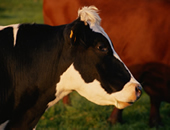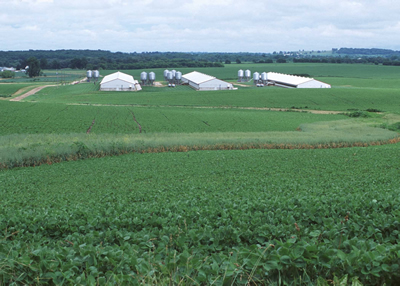Principal Investigator: Bruce Wilson
Organization(s): University of Minnesota Department of Bioproducts and Biosystems Engineering
Award Amount: $67,700
Start Date: 5/18/2009 | End Date: 4/30/2011
Project Manager(s): Rob Sip
FINAL REPORT: Validation of MinnFARM for use in Assessing TMDLs (PDF)
Background
 Runoff from feedlots may contain pollutants (manure or elevated nutrients) and in some cases can degrade water quality in nearby streams. One big concern is the movement of fecal coliform bacteria and other pathogens.
Runoff from feedlots may contain pollutants (manure or elevated nutrients) and in some cases can degrade water quality in nearby streams. One big concern is the movement of fecal coliform bacteria and other pathogens.
As of June 2008, there were a total of 2575 lakes and streams on the MPCA (Minnesota Pollution Control Agency) list of impaired waters and 1475 state waters requiring a TMDL (Total Maximum Daily Loads) assessment. Waters are listed on the impaired waters list if the fail to meet one or more of the water quality standards to ensure that the water is drinkable, swimmable, fishable or useable in other designated ways. A TMDL assessment identifies all sources of a pollutant and determines how much each source must reduce its contribution in order to meet the standard.
While feedlots contribute to fecal coliform and nutrient loading, determining their contributions in the actual TMDL is difficult. General load allocations provide limited information on what sources should be the targets of load reductions (such as feedlot runoff, stockpiles, manure application, wildlife, etc.).
In an effort to better asses pollutant load contributions from feedlots in waters and strategies for reducing them, the University of Minnesota developed a site-specific evaluation tool called the Minnesota Feedlot Annualized Runnoff Model (MinnFARM). However, MinnFARM was developed as a prioritization tool, to help identify the most important projects for state and federal cost-share. In order to contribute to TMDL load reductions MinnFARM needed to be refined.
The overall goal of this study was to assess, and possibly improve, MinnFARM as a tool for TMDL evaluations.
-
 A tool currently used to assess feedlots in Minnesota.
A tool currently used to assess feedlots in Minnesota. - It is an easy-to-use Excel-based evaluation system.
- MinnFARM uses simple inputs to compute annualized loads for phosphorus (P), chemical oxygen demand (COD), biological oxygen demand (BOD), total Kjeldahl nitrogen (TKN), and fecal coliform bacteria.
- MinnFARM estimates seasonal loadings for spring (April and May), summer (June, July, and August), fall (September and October), and winter (November, December, January, February, and March). These seasonal loadings are combined to estimate annual loading.
The specific objectives of this project were to:
- Collect, organize, and evaluate existing observed data on feedlot runoff;
- Validate the MinnFARM model for both loading at the feedlot edge and reductions in buffer areas using existing field data representative of Minnesota conditions;
- Modify MinnFARM to reflect field validation data and add algorithms into MinnFARM to include alternative runoff treatment systems such as the biofilter but not limited to specific treatments;
- Refine MinnFARM to improve user-friendliness and publish runoff and monitoring data in formats that can be assessed for developing or validating other feedlot runoff models;
Objective 1: Data Compilation
Selection of Data for Analysis
From initial literature review and inquiries with other researchers, researchers had the possibility of drawing data from seven different research projects and approximately twenty-four different feedlots. A total of 984 rainfall events were identified as possible candidates for model evaluation.
Screening criteria for data sets included the following: 1) Data collected in using natural or mechanically produced rainfall events (actual events preferred) and 2) Completeness of data reported in published papers or raw data files and the likelihood of accessing raw data files if needed through principal investigators or site visit.
After applying the screening method, the final data set for runoff water quantity analysis consisted of 179 events from 21 feedlots. Some of the events excluded from the water quantity analysis were still useful in assessing average concentrations used in MinnFARM. A total of 292 events were selected for the water quality analysis.
Objective 2: Data Analysis
Water Quantity
Feedlot runoff volume is predicted in MinnFARM using the curve number method. Input parameters for this method are the curve number and the initial abstraction depth, in addition to precipitation.
- Curve number: empirical parameter used in hydrology for predicting direct runoff or infiltration from rainfall excess.
- Initial abstraction depth: represents interception, depression storage and infiltration before the start of runoff.
- According to curve number theory, precipitation must exceed the initial abstraction depth in order to produce runoff for a given event. There is a detailed description of curve methods (including equations) in the Final Report.
Recommended Changes in Water Quantity Parameters
There appeared to be trends in the curve numbers with season, feedlot surface (concrete or dirt) and precipitation depth. Based on these trends, we recommended changing the current curve numbers to a constant value of 98 for concrete lots and 90 for dirt lots. An area-weighted curve number is recommended for lots with a mixture of concrete and dirt. Based on trends in the observed initial abstraction depths, we recommended the current version of MinnFARM be changed so that initial abstraction depth is also a function of precipitation depth.
Water Quality
Feedlot loading of pollutants is computed in MinnFARM by multiplying the runoff volume for an event by its representative concentration (nitrogen or phosphorus). In addition to values for total concentrations, the soluble and settleable fractions are needed inputs for simulating the removal of pollutants by vegetative buffers. Annual loading for total nitrogen, total phosphorus, COD, BOD and fecal coliforms is computed in MinnFARM. Unfortunately, most of the data sets did not include measurements of COD, BOD, and fecal coliforms, and therefore these pollutants were not included in the analysis. Similar to the runoff parameters, the variability in water quality concentrations was substantial. No trends could be found with respect to precipitation or other factors.
Recommended Changes in Water Quality Parameters
MinnFARM currently uses a constant value of 250 mg/L for total nitrogen and 85 mg/L
for total phosphorus. Fifty percent of nutrients are assumed to be soluble (dissolved) and
fifty percent are then settleable (particulate). Possible changes in MinnFARM include
using concentrations that vary between events or using different default concentrations.
Average concentrations across all feedlots (not averaged over all events) suggest an average TKN value of 239 mg/L and an average total P value of 60 mg/L. These average values are in reasonable agreement with those values currently used in MinnFARM. We therefore recommend not changing the current default concentrations.
Additionally, there are no changes recommended in the current representative concentration (particulate and soluble fractions) approach.
Vegetative Buffer Validation
In Minnesota, vegetative buffers are the most widely used treatment for feedlot runoff. Load reductions in buffers are a function of infiltration and filtration. Filtration removes settleable solids and infiltration removes both settleable and soluble nutrients. Separate algorithms are used in MinnFARM for these two components. Several data sets were used to evaluate the accuracy of the current MinnFARM approach.
Variability in the observed data, and the lack of data on soluble and particulate fractions, made the assessment of the accuracy of the current MinnFARM difficult. Results are sensitive to the default soluble fraction. Possible errors in estimating soluble fractions are caused by inaccuracies in the feedlot algorithm and not the buffer algorithm. Since we have little information for improving the buffer algorithm, and the current algorithm adequately approximates observed reductions using reasonably soluble fractions, no changes are therefore recommended in the current modeling of vegetative buffers.
Biofilters have been suggested as an alternative to vegetative-buffer treatment of feedlot runoff. A biofilter algorithm was developed and tested for use in MinnFARM. The biofilter algorithm assumes a two-chamber system, where the first chamber is the settling basin that acts as pretreatment for the removal of settleable solids, and the second chamber is the biofilter for the removal of contaminants by bio-chemical filtration.
Separate algorithms were developed for each of the chambers. These algorithms were based on a solution to a mass-balance equation. Evaluation of model accuracy focused on the second chamber.
The observed removal efficiencies were compared to those predicted using a first-order process and using a logistic process. Predicted removal efficiencies of nitrogen for the first-order process agreed reasonably well with observed values. The first-order model also performed reasonably well in predicting the removal efficiency of phosphorus. The logistic model poorly predicted the removal efficiencies of nitrogen but adequately predicted the removal efficiencies of phosphorus.
Objective 3: Modifications to MinnFARM
Currently MinnFARM is driven by Excel functions applied to cells located within several worksheets. This framework was too limited to incorporate the recommended changes and to include the new biofilter algorithm.
An equivalent Excel Visual BASIC code has therefore been created and used to implement recommended changes and the biofilter algorithm. However, feedback from important user groups is needed before the release of the new MinnFARM version. The new version also needs additional testing to ensure that it is robust and consistent. Future improvement in MinnFARM is dependent on obtaining better data sets. This study relied on previously published data that were collected to achieve their goals and therefore often didn’t collect information necessary for model improvement and evaluation.
Carefully designed collection efforts are needed to better understand complex processes on feedlots. For TMDL assessment, feedlot runoff also needs to be integrated into a broader modeling framework that considers multiple features of a comprehensive manure management plan.
Objective 4: User Friendliness and Observed Data
It was decided that MinnFARM user friendliness was adequate and no additional changes were made to the user interface. The observed data have been organized in easy to use format and have been given to Minnesota Department of Agriculture as part of the deliverables.

